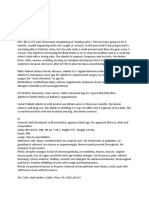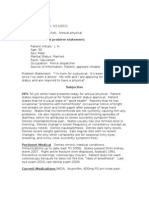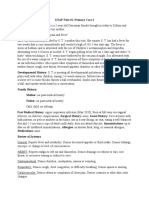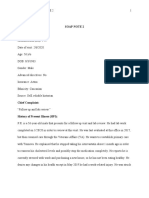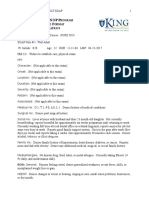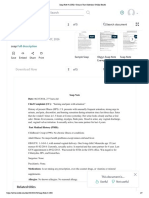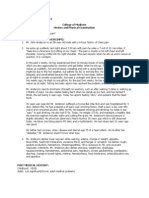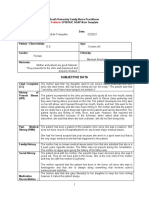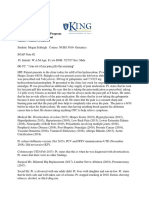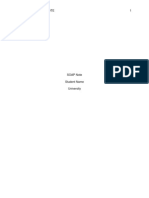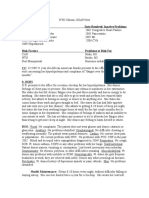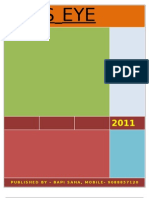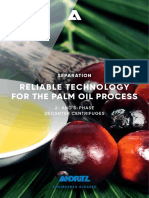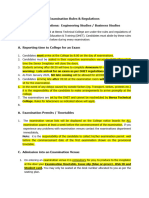SOAP Note
Uploaded by
Anonymous p0y5mmLQSOAP Note
Uploaded by
Anonymous p0y5mmLQRunning head: Nursing SOAP Note $ Journal
Nursing SOAP Note and Journal
Name
Institution
Running head: Nursing SOAP Note $ Journal
SUBJECTIVE: What details did the patient provide regarding his or her personal
and medical history?
Past Medical History
Hospitalizations and Health Maintenance
Surgical History: Urinary Track Infection at age 21.
Chronic Medical Problem
Psychiatric History: None
Immunizations: Patient does not receive regular flu vaccines.
Childhood Illnesses: Suffered from Asthma and Chicken pox.
Transfusions: None
Allergies: None
Screening tests: Patient does not go to see eye problems and has no eye problems. She
also doesnt see the dentist regularly but will make an appointment today. She has to
broken molars.
Has had a Pelvic Exam, Cervical smear and STD screening.
History of Present Illness:
Location: The patient feels pain at her urinary track.
Quality
Severity: The patient rates her pain at 6/10.
Timing (Frequency): Normally, patients normal urinary frequency was four times
everyday but for the past three days, the frequency has increased to up to six to eight
times.
Context: Patient says that she started experiencing symptoms of urinary track
infection three days ago. Her frequency of going to the bathroom increased from four
times daily to six/eight times daily. In addition to that, she experiences increased
Running head: Nursing SOAP Note $ Journal
burning during urination while urinating. She started experiencing lower abdominal
pains and thus made an appointment today.
Relieved by: The patient says that pain reduces a little between the urgency episodes.
Worsened by: Pain increases when she goes to the bathroom and cannot produce any
urine.
Associated signs and symptoms: Increased urinary frequency, burning sensation when
urinating, and abdominal pains
Review of Symptoms (Systems)
Patient does not suffer from fever, chills, fatigue, malaise and headache.
Constitutional
Eyes: Patient has no blurry vision, eye pain, itching or drainage.
Ears, Nose, Mouth, Throat: Patient does not suffer from ear pain, fullness, popping,
and loss of hearing or drainage. Does not suffer from nose drainage, loss of smell and
no sinus pressure. Has no sore throat or loss of taste and bleeding gums. However
suffers from tooth and gum pain and has difficulty in chewing.
Cardiovascular: Has no chest pains, syncope and shortness of breath.
Gastrointestinal: Not difficulty in swallowing. Denies nausea, vomiting, constipation,
melena, indigestion, reflux, dysphagia, diarrhea and loss of appetite.
Genitourinary: Bilateral lower quadrant abdominal pain/pressure.
Musculoskeletal: Complains of dysuria, polyuria. Burning, frequency and incomplete
bladder emptying without hematuria, offensive odor of urine or back/flank pain.
Skin and/or breasts: Denies rashes, moles, itching, acne or other skin changes.
Neurological: Denies any memory loss, imbalance and weakness.
Endocrine: Denies palpitations, orthopnea and syncope.
Hematologic/Lymphatic: Denies cough and sputum production.
Running head: Nursing SOAP Note $ Journal
Allergic/Immunologic: Patient suffers from no allergies.
Last Menstrual Period: 7/14/2011, lasted five days. Normal menstruation for patient.
Social History
Cultural Background
Education Level: N/A
Economic Condition: Patient unemployed and boyfriend works at a chicken
processing plant.
Number in household: Four, including the patient.
Marital Status: Stays with boyfriend
Lives with her boyfriend (father of her children)
Children: Two children, ages 1 and 3.
Occupation: Unemployed
Occupational Health Hazards. N/A
Nutrition: Cooks a lot of prepared frozen food.
Exercise: Does not have a regular exercise routine.
Tobacco use: She smokes packet per day.
Caffeine: N/A.
Sexual Activity: N/A
Contraception: N/A
Alcohol/recreational drug use: Does not drink alcohol.
Narcotic: Short history of prescription narcotic abuse but has been clean for two
months.
Safety Measures: Wears seat belt.
Family History
Mother had lung cancer, heart disease, hypertension and diabetes.
Running head: Nursing SOAP Note $ Journal
Father had diabetes.
Mothers uncle had problems with alcoholism.
OBJECTIVE: What observations did make during the physical assessment?
General: The patient is alert and awake and also responds appropriately and she is not
feverish. Weight is 129, height is 63 inches and BMI is 22.7.
Skin: Patients skin is warm and dry. Skin tone is also normal.
HEENT
Head: Head is normocephalic, a traumatic and symmetrical.
Eyes: Sclera and conjunctiva clear, no discharge, Pupils equal, round, and
reactive to light and accommodation.
Ears: Bilateral external ear size and shape. Both ears have three piercings
each, no masses or tragal tenderness. Patent canals with no odor, discharge or foreign
bodies bilaterally. Internal ear inspection shows a pink canal with a tympanic
membrane that is pearly gray, concave, with light reflex and visible bony landmarks
without ear cerumen.
Nose: Nares patent bilaterally, nasal septum midline; turbinates pink and
moist without nasal discharge. Mucus membranes pink, moist without lesions, hard
and soft palate intact.
Mouth: Uvula midline, tongue midline, sensitive gag response
Teeth/Gums: No teeth missing, 2 broken molars to the left upper and lower
dentit, evidence of active decay, gum redness, no puss or bleeding visualized.
Pharynx: Patient suffers from trachea midline without any lymphadenopathy.
Pharynx pink, tonsils 1+ without exudates or pitting.
Neck: Patient suffers from neck midline.
Heart: VS-BP 102/60, HR: 76, RR: 18
Running head: Nursing SOAP Note $ Journal
Lungs: Clear to auscultation without crackles, wheezes or rhonchi. Normal S1 and
amp; S2 without any spits, skips, rubs, gallops or murmurs.
Abdomen: Flat and symmetrical. No scars, dilated veins, rashes, lesions, peristalsis or
pulsations visible. Umbilicus midline, without bulges. Bilateral abdominal strie from
childbirth. Active bowel sounds in all four quadrants, no aortic, renal, iliac or femoral
bruits auscultated, no friction rubs heard over the liver or spleen. Abdomen is soft,
non-tender to light and deep palpation of upper quadrants and tender to light and deep
palpation of lower quadrants.
Back: No costovertebral angle or back tenderness to palpation.
Musculoskeletal: Maxillary and frontal sinuses non-tender tender to palpation.
No palpable masses or hepatosplenomegaly. Spleen and kidneys not felt. Aortic
pulsations slightly palpable.
ASSESSMENT: What were your differential diagnoses? Provide a minimum of
three possible diagnoses. List them from highest priority to lowest priority. What was
your primary diagnosis and why?
Possible diagnoses: Acute Pyelonephritis, Bladder Cystitis and Unitary Tract
Infection.
Most likely diagnosis: The patient is suffering from Unitary Tract Infection
and it was selected because the patient had the following symptoms; Urinary urgency
and burning sensation with urination, incomplete bladder emptying and Atypical
infections of the lower urinary tract.
PLAN: What was your plan for diagnostics and primary diagnosis? What was your
plan for treatment and management including alternative therapies?
Running head: Nursing SOAP Note $ Journal
Laboratory Testing: Urine Dipstick in office, results were positive for
leukocytes and nitrates with trace blood. Urine Culture, Sensitivity and microscopy
sent to the lab to confirm diagnosis.
Medications: Ciproflaxin 500mg PO BID for three days (Drugs short term therapy
duration)
Patient Education: A urinary tract infection stems from an infection in the kidneys,
bladder or urethra. These are mostly caused by E. Coli., Staph Saprophyticus and
others found in normal bowel flora.
Follow-up: No follow up visit is necessary for the UTI. Follow up with a dentist for
both the broken teeth and regular cleanings needed.
REFLECTION NOTES:
Urinary tract infections are prevalent in women and five to ten percent of adult
women suffer from unitary tract infection within a year, in others, it occurs three times
or more. Diagnosis is based on urine dipstick, microscopic urinalysis and urine
culture. Treatment involves antibiotic therapy.
References
Running head: Nursing SOAP Note $ Journal
(2013). Guidelines on Urological Infections. M. Grabe. Retrieved 29 July 2016, from
https://uroweb.org/wp-content/uploads/18_Urological-infections_LR.pdf
(1997) Hooton TM, Stamm WE. Diagnosis and treatment of uncomplicated urinary
tract infection. Infect Dis Clin North Ame Sep;11:(3)551-81.
http://www.ncbi.nlm.nih.gov/pubmed/9378923
Sthrer M, Blok B, Castro-Diaz D, et al. EAU Guidelines on Neurogenic Lower
Urinary Tract Dysfunction. Eur Urol. 2009 Jul; 56(1):81-8.
http://www.ncbi.nlm.nih.gov/pubmed/19403235
Arcangelo, V.P. & Peterson, A.M. (2006). Pharmacotherapeutics for advanced
practice: A practical approach (2 nd ed.). Philadelphia: Lippincott Williams
& Wilkins.
Bickley, L. S. (2009). Bates pocket guide to physical examination and history taking
(6 th ed.).
Philadelphia: Lippincott Williams & Wilkins.
Domino, F. J. (Eds.). (2010). The 5-minute clinical consult. Philadelphia:
Lippincott Williams &
Lee, U. J. & Goldman, H. B. (2011, March 15). Urinary tract infections in
women.. Epocrates,
Inc. Retrieved July 30, 2011 from
https://online.epocrates.com/noFrame/showPage.do?
method=diseases& MonographId=77
You might also like
- Soap N - Urinary Tract Infection - Public HealthNo ratings yetSoap N - Urinary Tract Infection - Public Health7 pages
- Peds 4 Soap Note S Kelly 5023 100 From KellyNo ratings yetPeds 4 Soap Note S Kelly 5023 100 From Kelly12 pages
- Published by - Bapi Saha, Mobile-9088857120No ratings yetPublished by - Bapi Saha, Mobile-90888571204 pages
- Dermatoglyphics: A Brief Review: January 2016No ratings yetDermatoglyphics: A Brief Review: January 20166 pages
- Coherence in The Quran and A Brief Analysis of Sura Al BaqarahNo ratings yetCoherence in The Quran and A Brief Analysis of Sura Al Baqarah52 pages
- Construction Project Schedule Template G1 Residential BuildingNo ratings yetConstruction Project Schedule Template G1 Residential Building4 pages
- Systems Analysis and Design 11th Edition Tilley Test Bank PDF Download Full Book with All Chapters100% (9)Systems Analysis and Design 11th Edition Tilley Test Bank PDF Download Full Book with All Chapters40 pages
- Read The Extract From The Short Story QWERTYUIOP Below and Answer The Questions That FollowNo ratings yetRead The Extract From The Short Story QWERTYUIOP Below and Answer The Questions That Follow6 pages
- Organized Labor and the Black Worker, 1619-1981 Philip S. Foner - Own the ebook now with all fully detailed content100% (1)Organized Labor and the Black Worker, 1619-1981 Philip S. Foner - Own the ebook now with all fully detailed content50 pages
- Account Statement: Tizar Infra Projects Private Limited NO. 95 Palayam Bazaar Woraiyur TiruchirappalliNo ratings yetAccount Statement: Tizar Infra Projects Private Limited NO. 95 Palayam Bazaar Woraiyur Tiruchirappalli2 pages
- Lower Level Upper Level: Men's and Home Men's and HomeNo ratings yetLower Level Upper Level: Men's and Home Men's and Home1 page
- Chemistry Criterion D: Chemical Compounds in Daily Life 1No ratings yetChemistry Criterion D: Chemical Compounds in Daily Life 13 pages
- Umali V JBC July 25, 2017 G.R. No. 228628 Velasco, JR., J. FactsNo ratings yetUmali V JBC July 25, 2017 G.R. No. 228628 Velasco, JR., J. Facts1 page
- Knowledge, Attitudes, and Practices (Kap) Surveys During Cholera Vaccination Campaigns: Guidance For Oral Cholera Vaccine Stockpile CampaignsNo ratings yetKnowledge, Attitudes, and Practices (Kap) Surveys During Cholera Vaccination Campaigns: Guidance For Oral Cholera Vaccine Stockpile Campaigns41 pages
- 4G Single Radio Access Network (SRAN) : Course Code: TRC-830No ratings yet4G Single Radio Access Network (SRAN) : Course Code: TRC-8303 pages
- Coherence in The Quran and A Brief Analysis of Sura Al BaqarahCoherence in The Quran and A Brief Analysis of Sura Al Baqarah
- Construction Project Schedule Template G1 Residential BuildingConstruction Project Schedule Template G1 Residential Building
- Systems Analysis and Design 11th Edition Tilley Test Bank PDF Download Full Book with All ChaptersSystems Analysis and Design 11th Edition Tilley Test Bank PDF Download Full Book with All Chapters
- Read The Extract From The Short Story QWERTYUIOP Below and Answer The Questions That FollowRead The Extract From The Short Story QWERTYUIOP Below and Answer The Questions That Follow
- Organized Labor and the Black Worker, 1619-1981 Philip S. Foner - Own the ebook now with all fully detailed contentOrganized Labor and the Black Worker, 1619-1981 Philip S. Foner - Own the ebook now with all fully detailed content
- Account Statement: Tizar Infra Projects Private Limited NO. 95 Palayam Bazaar Woraiyur TiruchirappalliAccount Statement: Tizar Infra Projects Private Limited NO. 95 Palayam Bazaar Woraiyur Tiruchirappalli
- Lower Level Upper Level: Men's and Home Men's and HomeLower Level Upper Level: Men's and Home Men's and Home
- Chemistry Criterion D: Chemical Compounds in Daily Life 1Chemistry Criterion D: Chemical Compounds in Daily Life 1
- Umali V JBC July 25, 2017 G.R. No. 228628 Velasco, JR., J. FactsUmali V JBC July 25, 2017 G.R. No. 228628 Velasco, JR., J. Facts
- Knowledge, Attitudes, and Practices (Kap) Surveys During Cholera Vaccination Campaigns: Guidance For Oral Cholera Vaccine Stockpile CampaignsKnowledge, Attitudes, and Practices (Kap) Surveys During Cholera Vaccination Campaigns: Guidance For Oral Cholera Vaccine Stockpile Campaigns
- 4G Single Radio Access Network (SRAN) : Course Code: TRC-8304G Single Radio Access Network (SRAN) : Course Code: TRC-830


